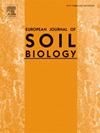Ant community composition defines nest mound dynamics across successional stages in desert restoration
IF 3.3
2区 农林科学
Q1 ECOLOGY
引用次数: 0
Abstract
Ants play critical roles as ecosystem engineers in desert environments. This study investigates how ant community composition and diversity influence mound morphology and spatial distribution across a succession of revegetated areas in the Tengger Desert, China. We examined four stages of revegetation—5 years (5a), 8 years (8a), 34 years (34a), and 57 years (57a)—representing different stages in the successional process. Using a combination of sampling techniques, we found that ant abundance peaked in intermediate stages (8 years), while α and β diversity increased linearly with succession. Mound density and size decreased significantly after 34 years, and spatial distribution shifted from aggregated patterns in early and intermediate stages to a uniform distribution in the later stage (57 years). Notably, β diversity and the abundance of the dominant species, Formica cunicularia, were key drivers of these changes. This study highlights the importance of β diversity in influencing ecosystem engineering processes during long-term successional stages. These findings provide a theoretical basis for future restoration strategies that integrate ant community dynamics in desertified ecosystems.

蚁群组成决定了荒漠恢复演替阶段的巢丘动态
蚂蚁在沙漠环境中扮演着生态系统工程师的重要角色。研究了腾格里沙漠不同复植区蚂蚁群落组成和多样性对土丘形态和空间分布的影响。我们研究了5年(5a)、8年(8a)、34年(34a)和57年(57a) 4个阶段的植被恢复,它们代表了演替过程的不同阶段。结合采样技术,我们发现蚂蚁丰度在中期(8年)达到峰值,而α和β多样性随演替线性增加。34 a后土丘密度和大小显著减小,空间分布由早期和中期的聚集型向后期(57 a)的均匀分布转变。β的多样性和优势种塑木(Formica cunicularia)的丰度是这些变化的主要驱动因素。该研究强调了β多样性在长期演替阶段影响生态系统工程过程中的重要性。这些发现为未来在沙漠化生态系统中整合蚂蚁群落动态的恢复策略提供了理论基础。
本文章由计算机程序翻译,如有差异,请以英文原文为准。
求助全文
约1分钟内获得全文
求助全文
来源期刊

European Journal of Soil Biology
环境科学-生态学
CiteScore
6.90
自引率
0.00%
发文量
51
审稿时长
27 days
期刊介绍:
The European Journal of Soil Biology covers all aspects of soil biology which deal with microbial and faunal ecology and activity in soils, as well as natural ecosystems or biomes connected to ecological interests: biodiversity, biological conservation, adaptation, impact of global changes on soil biodiversity and ecosystem functioning and effects and fate of pollutants as influenced by soil organisms. Different levels in ecosystem structure are taken into account: individuals, populations, communities and ecosystems themselves. At each level, different disciplinary approaches are welcomed: molecular biology, genetics, ecophysiology, ecology, biogeography and landscape ecology.
 求助内容:
求助内容: 应助结果提醒方式:
应助结果提醒方式:


